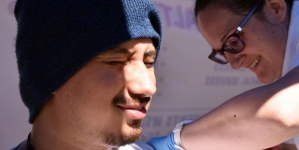-
Tips for becoming a good boxer - November 6, 2020
-
7 expert tips for making your hens night a memorable one - November 6, 2020
-
5 reasons to host your Christmas party on a cruise boat - November 6, 2020
-
What to do when you’re charged with a crime - November 6, 2020
-
Should you get one or multiple dogs? Here’s all you need to know - November 3, 2020
-
A Guide: How to Build Your Very Own Magic Mirror - February 14, 2019
-
Our Top Inspirational Baseball Stars - November 24, 2018
-
Five Tech Tools That Will Help You Turn Your Blog into a Business - November 24, 2018
-
How to Indulge on Vacation without Expanding Your Waist - November 9, 2018
-
5 Strategies for Businesses to Appeal to Today’s Increasingly Mobile-Crazed Customers - November 9, 2018
Can More Outside Time Help Kids’ Eyesight?
Parents should push children to spend more time in outdoor games as it will improve their health and keep them in healthy weight range as well.
Advertisement
This finding has now been confirmed in a number of other studies from the US, Singapore and China.
The parents of each child at the 12 schools were asked to keep a diary recording the amount of time their youngster spent playing outdoors over the weekend. The treatment group (952 children) had an extra 40 minutes of outdoor activities added to each school day, and the children in the control group (951 children) carried on with their usual routine. In East and South-East Asia, about 90% of school graduates have myopia. Past studies had shown that family history, genetics and some childhood activities may be also responsible for myopia.
In a bid to stem the tide of a nation of specs-wearing citizens, researchers added a daily outdoor activity class at school for three years for children in Guangzhou, China. Six of schools implemented a program that required a compulsory 40-minute session of outdoor play each day.
Dr. He and his colleagues wrote in their study that their investigation “achieved an absolute difference of 9.1 percent in the incidence rate of myopia, representing a 23 percent relative reduction in incident myopia after 3 years”.
The reduction in the risk of nearsightedness found in the study is important, because children who develop nearsightedness at a young age are most likely to develop worse myopia (the medical term for nearsightedness) later on, the researchers said.
Led by Mingguang He of Sun Yat-sen University, the study team found that after three years 30.4 percent of the children in the first group had myopia versus 39.5 percent of the control group.
There were a few evaluations indicating the safety effect of spending additional time outside against the development of nearsightedness, but the majority of this proof comes from different cross-sectional research (surveys) data that recommend “associations” instead of “causalities”.
In a linked editorial, Dr. Michael Rekpa, of John Hopkins University School of Medicine, Baltimore, MD, calls for future studies to include information about the content of the activity, whether or not it can be standardized and how it differs from other studies, in order to inform decisions that could be made by schools regarding the implementation of activities.
Researchers used to think that the explanation for why some people become nearsighted (able to see close objects more clearly than those far away) and why some continue to have 20/20 vision until they are old and gray was mostly a function of our genes.
Advertisement
To increase the benefits, educational institutions in Chinese regions should let children spend more time outside and motivate parents to take them outside at the end of the week. The children in control schools also continued their “regular pattern”, according to hngn.





























